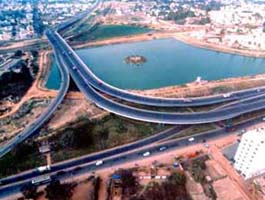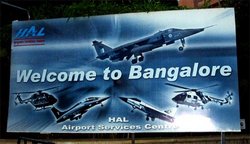Bengaluru Transport
 For most of the period after Indian independence, Bangalore, though a B-1 status city, was not considered to be one of India's "4 major metropolitan cities" and did not have the infrastructure required to support a population of 5 million. The fastest growing city in Asia now has to struggle with a constantly and rapidly increasing population of technocrats and blue collar workers.
For most of the period after Indian independence, Bangalore, though a B-1 status city, was not considered to be one of India's "4 major metropolitan cities" and did not have the infrastructure required to support a population of 5 million. The fastest growing city in Asia now has to struggle with a constantly and rapidly increasing population of technocrats and blue collar workers.
The local administration has attempted to overcome some of the shortcomings in the road systems by imposing one-way traffic systems and attempting to build a flyover system in the city. These initiatives have met with limited success. A flyover near the Domlur sector has been delayed twice, for about five months each time. The flyover near the Jayadeva Institute of Cardiology on Bannerghatta Road has also been delayed. Some of the flyovers and one-ways have mitigated the traffic situation moderately, but the volume of traffic continues to grow.
Some roads near Airport Road and the residential areas in Koramangala, two relatively important places in the city, were dug up for renovation instantly but have remained in this state for over two years. This has contributed to the discontent among the public. The local administration (Bangalore Development Authority or BDA) has also laid an 'Outer Ring Road' to ease out the congestion in the city. This was a welcome relief to the city dwellers a few years ago, since it did ease out substantial traffic in the city by diverting the truckers out of the city.
However recent growth in the city in the past couple of years has seen development of apartment complexes/townships beyond the outer ring road. This has once again brought the traffic situation back to square one. There have been talks of a 'Peripheral Ring Road' for sometime now. The local authorities are also undertaking the 'four laning' of some of the major roads around Bangalore (For example some stretches of the Sarjapura Road)
Rapid economic growth has been brought about by the IT and other associated industries. This has led to an escalation of the vehicular population to about 1.7 million, and which is growing at 8% per annum. Along with the unplanned nature of the rise and growth of these industries and the city's design the economic growth has also lead to massive traffic criss-crossing the city through the day.
Recent developments of self-contained apartment complexes/townships and such other ghettoization of the IT workforce and has led the State Government to plan for IT / Bio-Technology corridors at the outskirts of the city.
Bangalore's infrastructural woes have led to protests by students and IT workers in the city. In July 2004 Wipro's Azim Premji threatened to pull his company out of the city unless there was a drastic improvement in infrastructure over the next few years.
In 2005 the Central and State Governments allocated sizeable funding from their annual budgets towards the improvement of Bangalore's infrastructure. The new international airport and the planned metro system were specifically mentioned as projects to be funded. The State Government also announced plans to improve the city's roadways and introduce new traffic management plans.
Airport issues
The city's roads were not designed to accommodate the massive traffic that now prevails in Bangalore. As the city expands and absorbs other towns into it, the necessity for proper planning and road infrastructure to commute through the city increases.
Hindustan Aeronautics Limited owned and operated the airport that was subsequently used for commercial civil aviation by the Government of Karnataka. Most airports are controlled by the Airports Authority of India. This led to a prolonged three way tussle for operational ownership between the HAL, the Government of Karnataka and the Indian Air Force, which tests many of its indigenous aircraft there.
 Eventually a full scale international airport was planned at Devanahalli, 30 kilometers from Bangalore. The project, initially conceived in 1991, was repeatedly delayed due to red tape and tussles between the private companies involved and the Central and State Governments. Clearance for the construction of the $288 million airport was eventually granted in June 2004. The major stakeholders of this project include Siemens-Zurich Airport-L&T consortium, Airports Authority of India and Karnataka State Investment and Industrial Development Corporation. Construction work on the airport began in March 2005.
Eventually a full scale international airport was planned at Devanahalli, 30 kilometers from Bangalore. The project, initially conceived in 1991, was repeatedly delayed due to red tape and tussles between the private companies involved and the Central and State Governments. Clearance for the construction of the $288 million airport was eventually granted in June 2004. The major stakeholders of this project include Siemens-Zurich Airport-L&T consortium, Airports Authority of India and Karnataka State Investment and Industrial Development Corporation. Construction work on the airport began in March 2005.
Direct international flights to Bangalore are currently limited. The German airline Lufthansa is the only airline with non-stop flights to Bangalore from Europe, with service to Frankfurt's Main International Airport. Air India, Indian Airlines, Gulf Air also fly direct to many parts of Asia including Singapore, Bahrain, Dubai, Sharjah and Muscat. Currently, people coming to Bangalore on business visits from the United States, where many IT companies have a vested interest in the growth of the city, have to fly to Europe or Asia and then take a connecting flight to Bangalore.
However, the recent liberalization of the India's skies has lead to an influx of new international carriers. Starting in October 2005, three more international airlines will add service between Bangalore and Europe. Air France with service to Paris' Charles de Gaulle International Airport, British Airways' with service to London's Heathrow International Airport, and Northwest Airlines with service to Seattle's Seattle-Tacoma International Airport with a stop in Amsterdam's Schipol International Airport.
Liberalization has also meant an increase in the number of domestic carriers within India. Several low-cost carriers now operate flights between Bangalore and other major Indian cities. The low-cost carrier with the greatest number of flights into and out of Bangalore is Air Deccan, which has located its hub in Bangalore. Other low-cost domestic carriers flying to Bangalore include SpiceJet and Kingfisher Airlines. Additional entrants into the market are expected, but could find expansion of routes into Bangalore difficult due to space contraints that should be alleviated upon construction of the new International airport.
History of India
Telangana History | kerala History | Chhattisgarh History | Gujarat History | Himachal Pradesh History | Jharkhand History | Madhya Pradesh History | Manipur History | Karnataka History | orissa History | Punjab History | Rajasthan History | Sikkim History | Tamil Nadu History | Uttarakhand History | Uttarpradesh History | Tripura History | Meghalaya History | West Bengal HistoryBangalore
Bangalore News | Hospitals in Bangalore | Bangalore City | Map Of Bangalore | Bangalore Culture | Bangalore Education | Bangalore Economy | Bangalore Geography and Weather | Bangalore History | Bngalore Photos | Bangalore Property | Bangalore Transport | Bangalore Jobs | Restaurants in Bangalore | Bangalore Free Ads